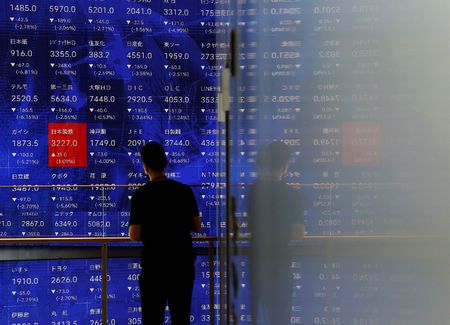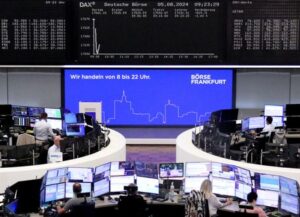(Reuters) -Share markets around the world tumbled and bonds rallied on Monday as fears the United States could be heading for recession sent investors rushing from risk assets while wagering interest rates will have to fall rapidly to rescue growth.
Japan’s Nikkei shed a staggering 12% to hit nine-month lows, entering bear market territory and marking its biggest one-day percentage drop since October, 1987.
Europe’s broad STOXX 600 index fell 3% and bank shares slid just over 4.5%. U.S. stock futures were sharply lower in a sign that Wall Street shares were set for a fresh selloff.
The yen hit a 7-month peak.
QUOTES:
SAMY CHAAR, CHIEF ECONOMIST, LOMBARD ODIER, GENEVA
“There are two things impacting pricing, one is the recession risk and that’s the main worry but on top of that there is a bit of anxiety around geopolitics and the expected retaliation from Iran and Hezbollah after the Israeli strikes.”
“On the first, it does feel that American economic conditions are still acceptable, we’re not seeing a pick up in lay offs, in job cuts. OK the data Friday was poor, but we need to be open to the possibility next month we get job growth number around 150,000 170,000.”
“It’s a game of ping pong. Positioning goes a bit far on one side and then reverses, and market moves have been extreme because positioning has been extreme. We’re going a bit far to the extremes, 3.70% seems a bit far on the U.S. 10 year yield. It was a good buy at 4.50% it is a good sell at 3.70%.”
MOHIT KUMAR, CHIEF ECONOMIST FOR EUROPE, JEFFERIES, LONDON
“First of all we would argue that positioning has been a big driver of recent market moves. U.S. equities, particularly the tech sector, was over owned and some froth needed to be cleared.”
“Our view on the U.S. employment picture has not changed. We have been on the camp of a modest weakening but not a disaster scenario.”
“We do not see the correction in risky assets as a start of a downturn. In our view, correction and clean up of positions does make sense.”
JIM REID, GLOBAL HEAD OF MACRO RESEARCH AND THEMATIC STRATEGY, DEUTSCHE BANK, LONDON
“Markets were on edge before Friday but a weak payrolls has really escalated a profound move across the globe. However the reality is that although payrolls was disappointing it’s hard to know how disappointing given the distortions from Hurricane Beryl. It’s like the market has added up 2+2 and made 9. It’s easily possible we’ll get the additional 3 and 2 to make up the total but we’re certainly not there yet. It’s hard to believe such market moves would have occurred in any other month.”
BEN BENNETT, HEAD OF INVESTMENT STRATEGY FOR ASIA, LGIM, HONG KONG
“Looks like a lot of trades that have done well in the first half of the year are unwinding, some more rapidly than others. I don’t think the rate hike by the Bank of Japan or the US employment report on Friday justify such a big reaction, so I suspect we’re seeing traders being stopped out of positions as volatility spikes.”
RICHARD KAYE, PORTFOLIO MANAGER, COMGEST, TOKYO
“The sudden narrowing of the Japan-U.S. yield gap has provoked the partial normalization of the yen, and the mistaken foreign hot money flows to banks and yen plays are being rightly sold off, which is at the centre of today’s and Friday’s move. Domestic demands SMIDs – GMO Payment, Fast Retailing, are significantly outperforming, and up in absolute terms in dollars for the month, ahead of major global indices.
“In short, not only the currency but the entire ‘value’ trade in Japan which had hijacked our market for two years is being unwound – and great news for serious investors who are most of the market participants, the silent majority eclipsed by recent hot money moves.”
KYLE RODDA, SENIOR FINANCIAL MARKET ANALYST, CAPITAL.COM, MELBOURNE
“The markets are in meltdown and it’s a sea of red across the world. The rapid move in the yen is putting downward pressure on Japanese equities, but it’s also driving an unwind of a major carry trade – investors had leveraged up by borrowing in yen to buy other assets, chiefly U.S. tech stocks.
We are basically seeing a mass deleveraging as investors sell assets to fund their losses. The rapidity of the move has caught a lot of investors off guard; there’s a lot of panic selling now, which is what causes these non-linear reactions in asset prices to pretty straightforward fundamental dynamics.”
DANIEL TAN, PORTFOLIO MANAGER, GRASSHOPPER ASSET MANAGEMENT, SINGAPORE
“In our view, five Fed rate cuts by the end of 2024 seem unlikely. More plausible are two cuts – one in September and one in November – with a total of up to 75 basis points by the end of the year. This suggests potential opportunities to increase duration in upcoming months. Overall, we believe emerging market bonds will perform well by the end of the year in a gradually declining interest rate environment.
“There may still be room for the recent sell-off in equities to continue, given the significant rally in technology stocks earlier this year and investors seeking to sell assets to cover losses.”
GEORGE BOUBOURAS, HEAD OF RESEARCH, K2 ASSET MANAGEMENT, MELBOURNE
“Markets are clearly concerned with the recent weaker economic data. However, extrapolating last Fridays Payrolls data appears an over-reaction as it is only one monthly reading. The rolling 3-month will be a better guide. It is clear the recent data momentum in the U.S. has slowed.
Given the Fed is expected to begin rate cuts (Implied Futures) before the U.S. election (Nov. 5), that may be seen as problematic optically despite the rational that conditions warrant a rate cut. This may add to some pre-election volatility.”
RYOTA ABE, ECONOMIST, SMBC, SINGAPORE
“I think USD/JPY will shift to 140-145 zone because of worse-than-expected NFP (U.S. non-farm payroll report) and the Middle East tensions. And the two reasons will likely weigh on Asian markets as market players will hesitate to take risks in this situation.
“Stronger yen will also weigh on Nikkei index as corporate margins will fall, as many corporates did not expect such a sharp and sudden rise of the Japanese yen at all.”
MASAFUMI YAMAMOTO, CHIEF CURRENCY STRATEGIST, MIZUHO SECURITIES, TOKYO
“There’s a risk that dollar-yen will fall further. The near term at the support will be 144.50, where the 90-week moving average is. If that is, I think the next target will be 140.
“But I would say that this the market pricing of a 50 basis rate cut by the Fed in the September meeting is too much. The U.S. economy is showing signs of slowdown, but it’s not as bad as market is pricing in.”
CHARU CHANANA, MARKET STRATEGIST, SAXO MARKETS, SINGAPORE
“U.S. economic data remains in the driving seat now and the more the U.S. soft landing assumption gets questioned, the further pullback we can see in equity and carry strategies where positioning has also been stretched.
“However, markets have gone a bit too far expecting the Fed rate cuts and four rate cuts priced in for this year seems a stretch considering that the June dot plot showed only one cut and the structural inflation forces in play.”
(Reporting by Ankur Banerjee and Vidya Ranganathan in Singapore and Harry Robertson and Alun John in London ; Editing by Sonali Paul, Himani Sarkar and Dhara Ranasinghe)





